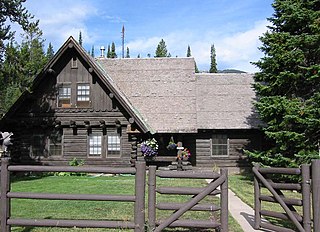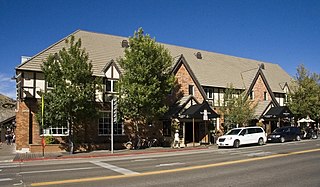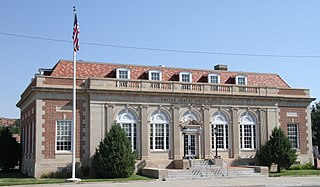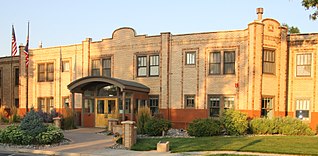
The Financial District of Lower Manhattan, also known as FiDi, is a neighborhood located on the southern tip of Manhattan in New York City. It is bounded by the West Side Highway on the west, Chambers Street and City Hall Park on the north, Brooklyn Bridge on the northeast, the East River to the southeast, and South Ferry and the Battery on the south.

This is intended to be a complete list of properties and districts listed on the National Register of Historic Places in Orleans County, New York. The locations of National Register properties and districts may be seen in a map by clicking on "Map of all coordinates". Two listings, the New York State Barge Canal and the Cobblestone Historic District, are further designated a National Historic Landmark.

Broadway–Flushing is a historic district and residential subsection of Flushing, Queens, New York City. The neighborhood comprises approximately 2,300 homes. It is located between 155th and 170th Streets to the west and east respectively, and is bounded on the north by Bayside and 29th Avenues, and on the south by Northern Boulevard and Crocheron Avenue. Broadway–Flushing is listed on the National Register of Historic Places.

The Old Administrative Area Historic District, also known as Beaver Creek, is the former headquarters area of Grand Teton National Park. The complex of five houses, three warehouses and an administrative building were designed in the National Park Service rustic style between 1934 and 1939 and were built by the Civilian Conservation Corps and the Public Works Administration. As part of the Mission 66 program, the park headquarters were relocated to Moose, Wyoming in the 1960s.

The Highlands Historic District in Grand Teton National Park is a former private inholding within the park boundary. The inholding began as a 1914 homestead belonging to Harry and Elizabeth Sensenbach, who began in the 1920s to supplement their income by catering to automobile-borne tourists. In 1946 the property was purchased by Charles Byron, Jeanne Jenkins and Gloria Jenkins Wardell, who expanded the accommodations by one or two cabins a year in a U-shaped layout around a central lodge. The lodge and cabins are constructed in a rustic log style, considered compatible with park architecture. The Highlands was neither an auto camp, which encouraged short stays, nor a dude ranch, which provided ranch-style activities. The Highlands encouraged stays of moderate length, providing a variety of relatively sedentary amenities. It was the last private-accommodation camp to be built in the park before the Mission 66 program created concessioner-operated facilities on public lands.

The Wort Hotel was built in downtown Jackson, Wyoming, United States by brothers John and Jess Wort, who were significant figures in the transformation of the economy of Jackson Hole from ranching to tourism. The somewhat Tudor-style building was the first luxury hotel in Jackson. The two-story building features brick facing, with half-timbering and stucco on the second floor and a series of gables facing the street.

The Yellowstone Main Post Office in Yellowstone National Park was built in Mammoth Hot Springs as part of a facilities improvement program by the United States Post Office Department (USPOD). The post office in Yellowstone was nominated to the National Register of Historic Places as part of a thematic study comprising twelve Wyoming post offices built to standardized USPOD plans in the early twentieth century. The Yellowstone facility is an understated classical structure with a low hipped roof and rounded dormers that uses a plan and a basic design vocabulary similar to that used in other post offices in the program. However it also includes restrained French Renaissance Revival elements, the only post office in the western United States to merge these two styles. It is somewhat at odds with the prevailing design theme expressed in other buildings in the former Fort Yellowstone district. The Yellowstone Main Post Office is also a contributing property to the Mammoth Hot Springs Historic District.

The Thermopolis Main Post Office in Thermopolis, Wyoming was built as part of a facilities improvement program by the United States Post Office Department. The post office in Thermopolis was nominated to the National Register of Historic Places as part of a thematic study comprising twelve Wyoming post offices built to standardized USPO plans in the early twentieth century.

The Central Troy Historic District is an irregularly shaped, 96-acre (39 ha) area of downtown Troy, New York, United States. It has been described as "one of the most perfectly preserved 19th-century downtowns in the [country]" with nearly 700 properties in a variety of architectural styles from the early 19th to mid-20th centuries. These include most of Russell Sage College, one of two privately owned urban parks in New York, and two National Historic Landmarks. Visitors ranging from the Duke de la Rochefoucauld to Philip Johnson have praised aspects of it. Martin Scorsese used parts of downtown Troy as a stand-in for 19th-century Manhattan in The Age of Innocence.

The Downtown Albany Historic District is a 19-block, 66.6-acre (27.0 ha) area of Albany, New York, United States, centered on the junction of State and North and South Pearl streets. It is the oldest settled area of the city, originally planned and settled in the 17th century, and the nucleus of its later development and expansion. In 1980 it was designated a historic district by the city and then listed on the National Register of Historic Places.

The Callaghan Apartments, also known as the Plaza Apartments and Hotel and the Plaza Hotel, was erected in 1918 in Hot Springs State Park in Thermopolis, Wyoming. It was at one time one of six hotels catering to tourists using the Big Spring of Thermopolis, a hot spring reputed to possess curative properties. The hotel was erected by bricklayer James Callaghan, who obtained a 98-year lease on the site commencing on January 1, 1918. Callaghan made his own bricks in a kiln he built on the site, completing the Callaghan Apartments in June 1918. He employed several nurses and a masseur for his guests. In 1921 Callaghan sold the property to Dr. P.W. Metz who renamed it The Plaza.

There are 75 properties listed on the National Register of Historic Places in Albany, New York, United States. Six are additionally designated as National Historic Landmarks (NHLs), the most of any city in the state after New York City. Another 14 are historic districts, for which 20 of the listings are also contributing properties. Two properties, both buildings, that had been listed in the past but have since been demolished have been delisted; one building that is also no longer extant remains listed.

The Newcastle Commercial District in Newcastle, Wyoming comprises the commercial center of this isolated Wyoming town. The town developed along the Burlington and Missouri Railroad in the late 1880s, with the commercial district taking shape between 1890 and 1952. The district includes twenty-three buildings, primarily commercial buildings, including two properties that are separately listed on the National Register of Historic Places: the Weston County Courthouse and the Newcastle Main Post Office. All of the buildings are considered "contributing properties" to the historic district.

The Alex Halone House in Thermopolis, Wyoming, United States, was built by Finnish immigrant Alex Halone for his personal residence in 1909–1910. Halone, a stonemason, built several stone structures in Thermopolis. Three generations of the Halone family were stonemasons. The grounds include a log Finnish sauna built by Alex and Eugene Halone with assistance from Lauri Suikaonen in 1946–51.

The Downtown Evanston Historic District in Evanston, Wyoming includes about sixty buildings in a compact downtown commercial district.

The Downtown Rock Springs Historic District is a historic district that was listed on the National Register of Historic Places in 1994, with an enlargement in 2023. It is roughly bounded by K, 4th, C, 2nd, A, and 5th Streets in downtown Rock Springs, Wyoming.

The Laramie Downtown Historic District comprises the historic core of Laramie, Wyoming. Established in 1868, Laramie owes its existence to the Union Pacific Railway, which chose the site and began selling property. By 1871 Laramie was the county seat of Albany County. The historic district includes many buildings dating to the earliest days of Laramie as well as railroad-related structures built between 1870 and 1938. 59 buildings are considered to be contributing structures in the 10-1/2 square block area.

The Downtown Rawlins Historic District comprises the historic center of Rawlins, Wyoming. It comprises the area between Second and Sixth Streets and Front to Buffalo Streets and along 5th Street between West Spruce and West Cedar. The town owes much of its living to the Union Pacific Railway, which took advantage of spring in the Rawlins area to establish services there.

The Lander Downtown Historic District comprises the commercial core of Lander, Wyoming. The district includes 16 buildings listed as contributing to the historic district, including a series of commercial buildings, the Noble Hotel, the grand Theatre and the Stockgrower's Bar. The Federal Building is included, and is individually listed on the National Register of Historic Places as well. Most date between 1890 and 1910. Most earlier buildings burned or were torn down and replaced by more permanent masonry structures. By 1910 an oil boom had begun in central Wyoming, providing an incentive to build substantial buildings. The district comprises most of the north side of Main Street between Second Street and Fourth Street, with three properties on the south side and one facing Lincoln Street at Third Street.

The University Neighborhood Historic District comprises the residential area south of the University of Wyoming in Laramie, Wyoming. The 24-block historic district is bounded on the north by University Avenue, the east by 15th Street, the south by Custer Street, and the west by 6th Street. The neighborhood's period of significance is from 1872 to 1958, a time when the area around the university was developed. Architectural styles in the district are diverse and the neighborhood is almost entirely composed of single-family residences.






















